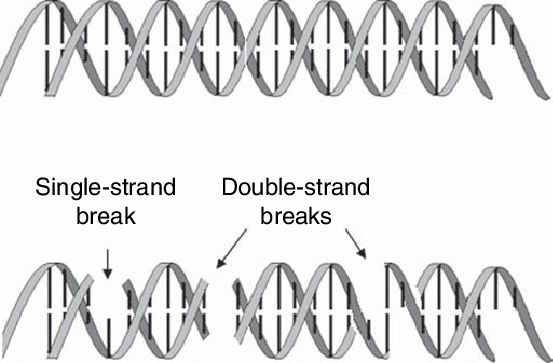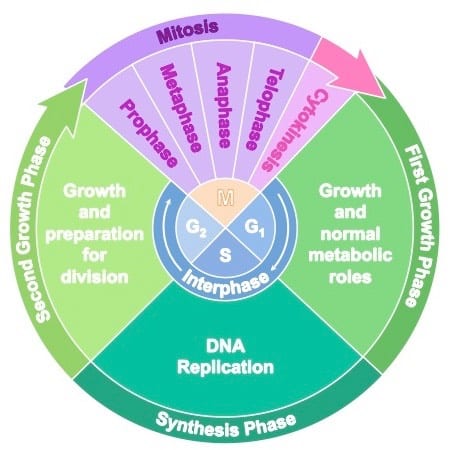Principles of Radiobiology
What is Radiobiology?
Radiobiology is the study of the effects of radiation on biological systems.
How does radiation damage cells?
Radiation damages cells by causing breaks within the structure of DNA. There are two primary mechanisms by which this damage occurs.
Direct Radiation Damage
Radiation impacts sufficient energy to DNA bonds to directly cause breaks.
Indirect Radiation Damage
Indirect damage occurs when radiation interactions outside of the DNA to produce free radicals which in turn damage DNA.
-
- A free radical is an atom or molecule carrying an unpaired electron in an outer shell.
- Hydroxide (OH-) is the most common free radical produced by radiation within the body. Hydroxide is produced in the body through interaction of water (H2O).
![]()
DNA Strand Breaks
What is DNA?
DNA (deoxyribonucleic acid) is shaped like a double helix. Each side of the helix is known as a "strand."
DNA Composition
Backbone comprised of deoxyribose (a sugar) and a phosphate group bound together by covalent bonds.
Nucleobases (base pairs) encode genetic information. The four bases are Cytosine (C), Guanin (G), Adenine (A), and Thymine (T). Importantly, only C-G and A-T pairs are allowed.
Single Strand Breaks
Single strand breaks occur when only one strand is damaged. This type of DNA damage in considered sub-lethal because they can generally be repaired.
When multiple single strand breaks occur close together on the same strand, the damage may be non-repairable (i.e. lethal).
Double Strand Breaks
Double strand breaks occur when both strands are broken within a few base pairs. This type of DNA damage in generally non-repairable and may result in cell death, sterilization (inability to reproduce), or mutation.
Factors Influencing Radiosensitivity
Law of Bergonie and Tribondeau
The law of Bergonie and Tribondeau states: The radiosensitivity of a cell is directly proportional to reproductive rate and is inversely proportional to its degree of differentiation.
This means that radiosensitivity increases with:
- Increased rate of cell division
- Low degree of specialization (stem cells are very radiosensitive)
- Higher metabolic rate
- Increased oxygenation
- Increased length of time they are actively proliferating
Cell Cycle Stage
The cell cycle is the series of distinct phases leading to duplication of DNA and, ultimately, cell division. The cell cycle is of interest because the radiosensitivity of a cell is dependent upon its stage in the cell cycle.
G1: First growth phase
The cell is performing normal functions and growing.
S: Synthesis phase
During the S phase, the cell replicates its DNA. S phase is the least radiosensitive phase of the cell cycle because the cell contains two copies of its DNA.
G2: Second growth phase
The cell is again performing normal functions and continues to grow.
M: Mitosis phase
The cell divides into two cells in a process called mitosis. Mitosis is the most radiosensitive phase both because mitosis is sensitive to disruption and because the cell is well oxygenated during this phase.
Temporal Aspects of Radiation Damage
Although radiation absorption is essentially instantaneous (~10-15 s), radiation damage accumulation from single strand breaks depends both on the temporal rate of damage and on the rate at which the cell repairs sublethal damage.
If DNA damage cannot be repaired, cell death may take between weeks and month depending on the type of cell. This is the reason for the delay in late effects described in the linear quadratic model.
Navigation
Not a Premium Member?
Sign up today to get access to hundreds of ABR style practice questions.



